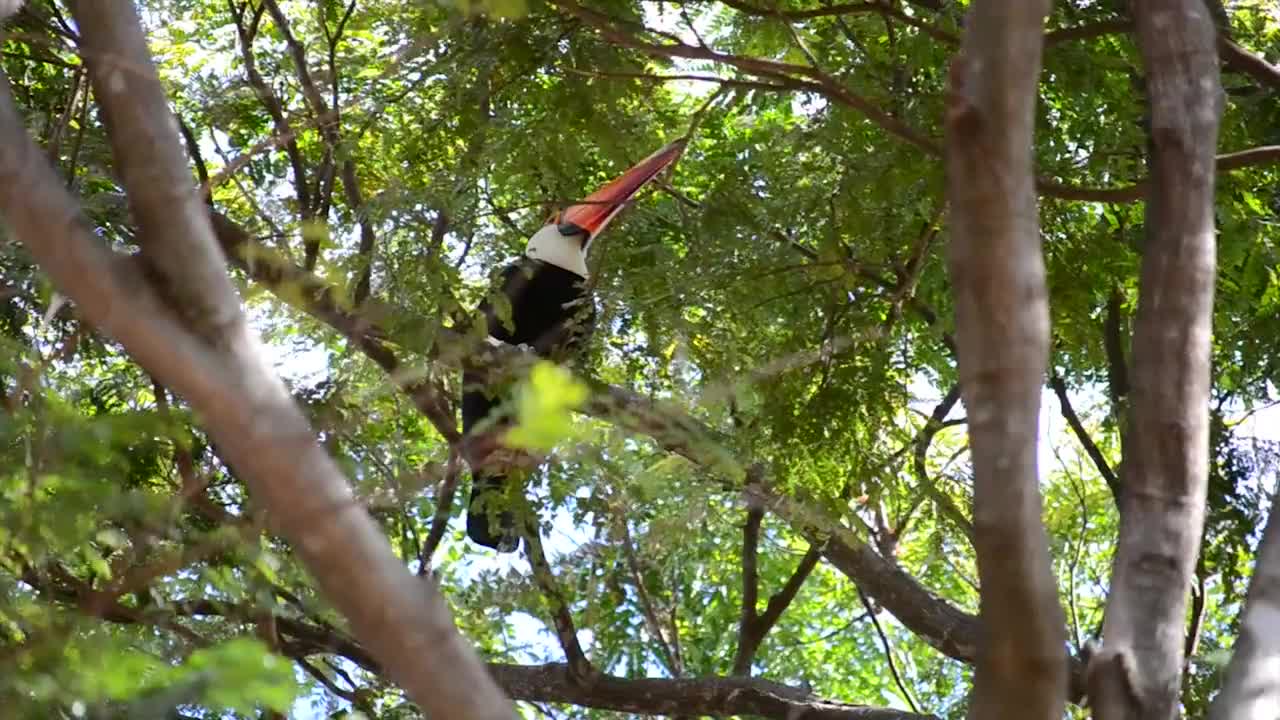Premium Only Content

Brazilian Tucano Bird Spotted On Tree Branch
In feeding, the toucan obtains food with the saw-edged bill and must toss back its head before swallowing. Although toucans are often considered to be primarily fruit eaters, most species consume a wide variety of food, including insects, snakes, frogs, and occasionally even small mammals. Toucans are also predators on the contents of songbird nests, consuming both eggs and nestlings. In foraging, toucans form large associations of two or more species that search for fruiting trees.
Measuring 63.5 cm (25 in.) in length, the toco toucan is the largest of all toucans. Its black body and white throat are overshadowed by its most recognizable trait: a large colorful beak.
The bright orange beak is about 19 cm (8 in.) long – one third of the bird’s total length. But despite its substantial size, the beak weighs less than you may think. Composed of the protein keratin, the structure of beak incorporates many air pockets allowing for a very low mass.
Furthermore, recent research has concluded that toucans regulate body temperature by adjusting the flow of blood to their beak. More blood flow means more heat is released. When toucans sleep, they tuck their beak under their feathers to keep them warm.
Toco toucans also use their beaks to pluck and peel fruit, their main source of food. In addition, the beak houses a flat tongue of the same length, which helps the toucan catch insects, frogs, and reptiles. Toco toucans also occasionally eat the eggs of other birds.
Although they spend a lot of time in trees, they are not very good at flying. Toucans mainly travel among trees by hopping. When they do take flight, they flap their wings vigorously and glide, traveling only short distances.
Toucans nest in the hollows of trees. They often move into cavities created and abandoned by woodpeckers.
Several toucans live together in a single hollow. It is in these hollows that they lay their eggs, generally two to four a year. Both parents incubate the eggs for 16-20 days. Once the chicks hatch, both parents continue to care for the young. Baby toucans are not born with an excessively large beak; the beak grows as the birds develop.
Native to South America, toco toucans inhabit a range of habitats including tropical forests, savannas, and shrubland.
-
 14:55
14:55
Degenerate Jay
19 hours agoThe Star Wars Battlefront 3 Situation Is Crazy - Could We Get A New Game?
148 -
 3:22
3:22
The Official Steve Harvey
1 day agoImagination is God's preview of the life He has for you | Steve Harvey Motivational Talks
2842 -
 LIVE
LIVE
PudgeTV
22 minutes ago🟠Yo Ho Ho and a Gaming on Rumble | Assassins Creed: Black Flag Playthrough
466 watching -
 11:26
11:26
China Uncensored
13 hours agoI'm Sorry, I Was Wrong About China
1.59K10 -
 37:28
37:28
The Hannah Faulkner Show
15 hours agoDEMS HAVE A NEW "STRATEGY"?! with Chrissy Clark | The Hannah Faulkner Show
1483 -
 8:38
8:38
ariellescarcella
13 hours agoQueer TikTok Keeps Getting Worse
756 -
 48:20
48:20
Esports Awards
16 hours agoFrom Cosplay to Center Stage: Myrtle Sarrosa’s Multifaceted Journey | Origins Podcast #9
18 -
 6:18:50
6:18:50
FreshandFit
9 hours agoAre You Smarter Than A 5th Grader?
312K43 -
 2:45:45
2:45:45
Badlands Media
16 hours agoDevolution Power Hour Ep. 358: Propaganda Wars, Trump's Economic Blueprint, and the Final Narrative Collapse
103K25 -
 2:55:04
2:55:04
TimcastIRL
10 hours agoFBI & GOP EXPOSE "Coup" Against TRUMP, Democrat Operative FELONIES Covered Up | Timcast IRL
241K85